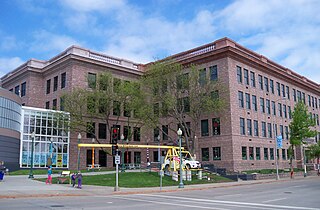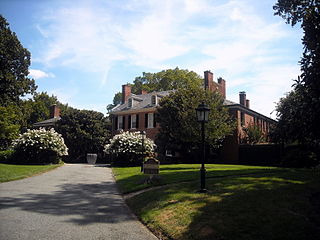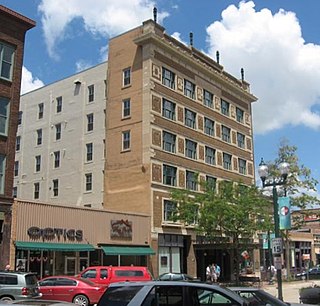
Sevierville is a city in and the county seat of Sevier County, Tennessee, located in eastern Tennessee. The population was 14,807 at the 2010 United States Census and 17,117 according to the 2019 census estimate.

Prairie School is a late 19th- and early 20th-century architectural style, most common in the Midwestern United States. The style is usually marked by horizontal lines, flat or hipped roofs with broad overhanging eaves, windows grouped in horizontal bands, integration with the landscape, solid construction, craftsmanship, and discipline in the use of ornament. Horizontal lines were thought to evoke and relate to the wide, flat, treeless expanses of America's native prairie landscape.

The Washington Pavilion of Arts and Science opened in 1999 and houses an art gallery, concert hall, large-format theater, and science museum in Sioux Falls, South Dakota, United States. Its building, the former Washington High School, is listed on the National Register of Historic Places.

The George Perkins Marsh Boyhood Home, also known as the Marsh-Billings House, is the architectural centerpiece of Marsh-Billings-Rockefeller National Historical Park, on Vermont Route 12 in Woodstock, Vermont, United States. The house, built in 1805 and enlarged several times, is historically significant as the boyhood home of George Perkins Marsh (1801–1882), an early conservationist, and as the home later in the 19th century of Frederick H. Billings (1823–1890), a businessman and philanthropist who was a cofounder of the Northern Pacific Railroad. It is also architecturally significant as a high-quality example of Queen Anne architecture, alterations and enlargements commissioned by Billings and designed by Henry Hudson Holley. The house and its surrounding gardens were declared a National Historic Landmark in 1967. The 550-acre (220 ha) estate on which it stands was given by Mary French Rockefeller and Laurance Rockefeller to the people of the United States in 1992.

The Sioux Quartzite is a Proterozoic quartzite that is found in the region around the intersection of Minnesota, South Dakota, and Iowa, and correlates with other rock units throughout the upper midwestern and southwestern United States. It was formed by braided river deposits, and its correlative units are thought to possibly define a large sedimentary wedge that once covered the passive margin on the then-southern side of the North American craton. In human history, it provided the catlinite, or pipestone, that was used by the Plains Indians to carve ceremonial pipes. With the arrival of Europeans, it was heavily quarried for building stone, and was used in many prominent structures in Sioux Falls, South Dakota and shipped to construction sites around the Midwest. Sioux Quartzite has been and continues to be quarried in Jasper, Minnesota at the Jasper Stone Company and Quarry, which itself was posted to the National Register of Historic Places on January 5, 1978. Jasper, Minnesota contains many turn-of-the-century quartzite buildings, including the school, churches and several other public and private structures, mostly abandoned.

The Sioux County Courthouse is a Richardsonian Romanesque courthouse in Orange City, Iowa, the county seat of Sioux County, Iowa. Designed by Wilfred Warren (W.W.) Beach, it was built from 1902 to 1904.

The Federal Building and U.S. Courthouse, also known as U.S. Courthouse, Sioux Falls, is a historic federal office and courthouse building located at Sioux Falls in Minnehaha County, South Dakota. The building is still in use as a federal courthouse, being the seat of the United States District Court for the District of South Dakota. The structure is listed on the National Register of Historic Places.

The Grand Lodge and Library of the Ancient Free and Accepted Masons in Sioux Falls, South Dakota is a building from 1924. It was listed on the National Register of Historic Places in 1976.

Evermay is a historic Federal architecture-style house at 1623 28th Street, Northwest, Washington, D.C., in the Georgetown neighborhood. The property originally extended south to Q Street, but the other houses were divided from the property.

Perkins & McWayne was an architectural partnership of Robert Perkins and Albert McWayne.

St. Wenceslaus Parish is a Catholic parish of the Roman Catholic Diocese of Sioux Falls in Tabor, South Dakota in the Midwestern United States. Its historic red brick church, built in 1898, was listed as St. Wenceslaus Catholic Church and Parish House on the National Register of Historic Places on December 13, 1984, as part of a "Thematic Nomination of Czech Folk Architecture of Southeastern South Dakota".
Wallace L. Dow, often known as W.L. Dow, was an architect of Sioux Falls, South Dakota.
The National Register Information System (NRIS) is a database of properties that have been listed on the United States National Register of Historic Places. The database includes more than 84,000 entries of historic sites that are currently listed on the National Register, that were previously listed and later removed, or that are pending listing. The database includes approximately 45 pieces of data for each listed property. Accuracy of the NRIS database may be imperfect. For example, a 2004 paper addressed accuracy of spatial location data for part of the NRIS content.
Zeona is an extinct town in Perkins County, in the U.S. state of South Dakota. The GNIS classifies it as a populated place.

The flag of Sioux Falls, South Dakota, consists of a zigzag pattern of thin white and blue lines, which divides an upper blue portion and a lower pinkish-red portion, and a yellow sun in the upper left corner. The zigzag represents the namesake falls of the Big Sioux River. The blue color and the sun allude to the flag of South Dakota. The pinkish-red portion represents the Sioux Quartzite nearby. The upward direction of the design represents the growth of Sioux Falls. The red, white and blue colors included in the flag are also a reference to the flag of the United States while maintaining city and state pride.

The Hotel on Phillips is a hotel at 100 N. Phillips Ave. in Sioux Falls, South Dakota. It is located in the former Sioux Falls National Bank building, a skyscraper built in 1917, during World War I. The building was listed on the National Register of Historic Places in 1979 as "Sioux Falls National Bank Building". The property has also been known as the 100 North Phillips Building.

Old Main, originally known as University Hall and Main Hall, is a historic university building at the University of South Dakota. Originally built in 1883, it is the oldest building on campus, despite having been rebuilt after an 1893 fire. It has been listed on the National Register of Historic Places since 1973.

The Carpenter Building, historically the Carpenter Hotel or Hotel Carpenter and known colloquially as The Carpenter, is a historic building at 221 South Phillips Avenue in downtown Sioux Falls, South Dakota. Originally serving as a hotel from 1912 to 1966, it is now used for retail and apartment space. It was listed on the National Register of Historic Places in 1986.

L.D. Miller Funeral Home, commonly known as the Miller Funeral Home, is a historic building at 507 South Main Avenue in Sioux Falls, South Dakota. It was listed on the National Register of Historic Places in 1983.

Cathedral Historic District, originally the Sioux Falls Historic District, is a 79-acre (32 ha) area located in Sioux Falls, South Dakota. Named for its centerpiece and key contributing property, the Cathedral of Saint Joseph, the district covers the neighbourhood historically known as Nob Hill, where multiple prominent pioneers, politicians, and businessmen settled in the late 19th and early 20th centuries. These homes primarily reflect Queen Anne and Mediterranean Revival architectural styles. In 1974, the neighborhood was listed as a historic district on the National Register of Historic Places (NRHP); at the time of this listing, there were 223 buildings, not all contributing, within the district's boundaries.




















